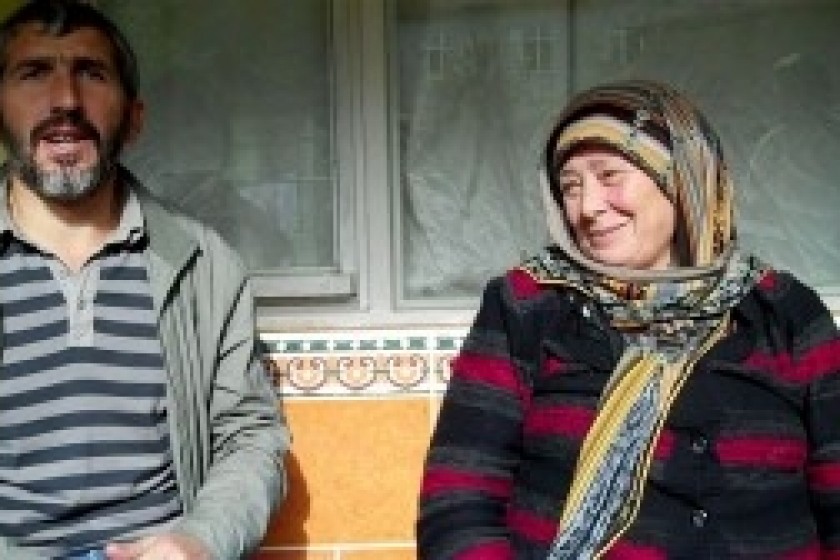
The Armenian-Speaking Muslims of Hamshen: Who Are They? (Part 5)
By Vahan Ishkhanyan
(Part 1, Part 2, Part 3, Part 4)
Weddings
The time had come to take the bride, Julya Karabajakov, from the village of Çamurlu, but her native home is in the Kyzyl-Kiya town in Kyrgyzstan, To uphold the wedding tradition, the house of Hizir Yılmaz, a relative of the Karabajakov’s, was used instead. Hizir is one of the last shepherds of Hamshen with a flock of 2,000. Julya’s father didn’t come to the wedding. Her mother, Hediye and a sister did.
64 year-old Hediye has eight children. One is a son. “We wanted a bride, but they refused so my son stole her away. One month later the wedding took place. We prepared a long table with drink and all. One thousand loaves of bread were ordered,” she notes, referring to the Turkish wedding difference. In Kyrgyzstan, they only marry Hamshentsis. There have been only two cases where a man took a Russian bride. They separated soon afterwards. Here, she’s noticed that the Hamshen will also marry other nationalities.
Khachik and I were listening to the Hamshen songs sung by the women who had painted the bride’s hands with henna that morning and interviewing Hediye. In the meantime, Anahit was video-recording the bride’s visit to the local beauty parlor.
 |
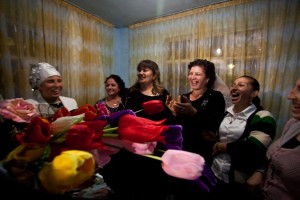 |
| Çamurlu: Taking the bride | The bride’s sisters demand “bakhshish” (gift payment) from the groom |
Chanchanatsin ard ounim / I have a field in Chanchanats
Chachen ourman ergena / A dried leaf is longer than it
Janchetsi nshanlouit / I met your betrothed
Kinte ourman ergen a / His nose is longer than him
“The person making the major decisions regarding the bride’s make-up is the elder sister-in-law (wife of husband’s brother). But there was an argument about her nails. The bride’s sister demanded that she get artificial nails but the sister-in-law was opposed to it. When the bride was done, the groom came and paid the entire bill. Julya was saying that the Hopa-Hamshens take the bride straight from the beautician’s shop, while according to their customs, the bride is first taken home and now they are demanding that they pick her up from the house,” recounted Hediye
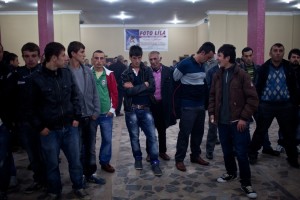 |
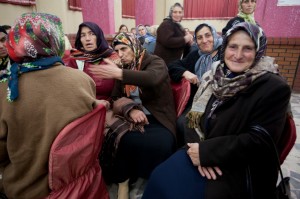 |
| Kemalpaşa wedding: Young men | …Womenfolk are sitting and waiting |
It was already dark when they brought the bride home and the groom’s family immediately showed up. Zurna and dhol music rang out and everyone joined in a circle-dance. Aydın Yenigül, the groom, entered the house, but his path was blocked by the bride’s sister and another woman. They let his pass when he gave them some money. Aydın tied a red belt around the bride’s waist and popped open a bottle of champagne, the only alcoholic drink at the wedding.
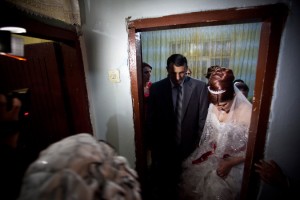 |
| Aydin and Zulya |
The wedding took place in Kemalpaşa. Young folk were dancing in the center of the hall. Sitting on chairs around them were the women wearing headscarves. There was neither food nor drink.
“Why isn’t there any drink? Does Islam prohibit it?” I ask Aydın’s father İzzet Yenigül, who is watching the dancers.
“Yes, religion forbids alcoholic drink,” he says.
Betrothals
In Hopa, engagements take place in a smaller hall. The women are seated and the men standing, as they observe the ceremony taking place. Rings tied to a red ribbon are placed on the fingers of Mukerem Aksu and Sevim Vayiç. Then, Sevim’s brother cut the ribbon after the groom’s side paid him with paper money.
Then, the open engagement - Açık neshan - took place; when the groom is present. (The closed ceremony - kapal neshan - is when the groom is absent.) The guests place paper money on the engagement table, eat a piece of chocolate, and then get their picture taken with the bride and groom.
The wedding will most likely take place in a year. In the past, engaged couples would probably wait 3-4 years. The bride’s father told the groom – ‘do not look at the girl’s face till the wedding’.
The guests hand out little packets of juice and pastries. Everyone gets into a circle dance to the accompaniment of bagpipe music. Given that the hall was narrow, the dancers are forced to spill out onto the hall’s courtyard under a night sky.
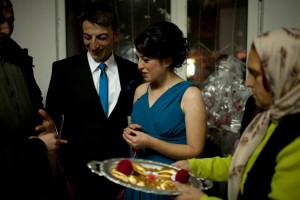 |
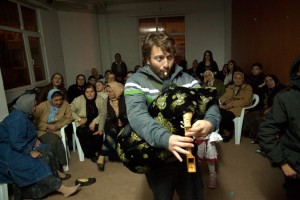 |
| Mukerem and Sevim | Muslim Aksu: “I had a duduk-like instrument but dreamed of a “tulum”. I worked harvesting tea one season and earned 400 lira. I used the money to by this “tulum” |
******
The tulum (bagpipe) is widely played by the Turkish-speaking Hamshen. The kaval (flute) is the instrument favored by Hopa Hamshens, but the tulum is gradually being played more and more in Hopa as well. In the Hayteh Bar, you’ll now hear both. Back in the day, you’d have to travel to Çamlıhemşin to purchase a tulum. Shops in Hopa now sell the instrument.
 |
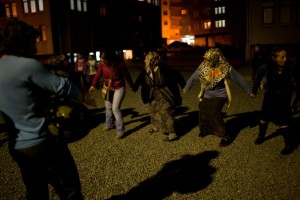 |
| Engagement Party: Only juice and pastry is served | Engagement Party: The hall was too narrow for the dancers |
Muslim Aksu, the 22 year-old tulum player at the engagement party, learnt to play from a Turkish-speaking Hamshen in the nearby town of Fındıklı. “I had an instrument similar to a duduk but I dreamt of owning a tulum. One year I got a job picking tea and saved 400 lira and bought this tulum you see me playing,” Muslim says. The young man plays in restaurants and at weddings. He can make 250 lira at a wedding gig. Throw in the tips, and Muslim can pocket up to 500. He’s also started to play the kaval. Muslim plans to go to Istanbul to master the tulum.
****
“I would like you to meet Turgay Köse, a Turkish-speaking Hamshen,” Cemil tells me at the engagement party.
“We are assimilated Hamshens. They are the real ones,” Turgay says.
Ali Riza isn’t assimilated. He speaks Armenian and was overjoyed to learn that we were Armenian. Ali calls himself Armenian but said it would be best to put the genocide issue behind us and become friends with Turkey. An argument in Turkish breaks out - on the one side, Turgay and a young Laz; on the other, Ali. I turn to Khachik to fill me in. Turgay and the Laz are arguing that we should never forget the genocide or stop working to get it recognized. They go even further, saying that we must struggle to get Turkey to recognize it and pay compensation.
Now, that’s something unexpected. One the one hand you have an assimilated Hamshentsi, who no longer speaks the native tongue, and a Laz calling for the recognition of the genocide. Opposed, is a Hamshentsi who identifies himself as Armenian and who speaks Homshetsma.
“It’s a political disagreement,” Cemil explains, “Ali Riza is a Kemalist who defends the official Turkish view. The others are communists, left-wingers. The left in Turkey says that that the government should recognize the genocide and pay compensation.”
 |
| Necla and Oghyuz |
A Loving Family of Adversary Peoples
Every time Oğuz talks about his feelings for Necla he gets emotional. “I love Necla more now than the first time I confessed my love to her.”
The couple first met twenty years ago in the Nalya snack shop owned by Oğuz. The man was serving her a meal he had prepared and never stopped confessing his love to Necla.
Necla laughs – “So many years have passed and we’ve gotten older, but you still talk of love.”
43 year-old Oğuz Koyouncu is a Laz. Necla Vayiç, his 37 year-old wife, is a Hamshen.
The two were born in Hopa but for many years resided in Kemalpaşa, the town where they met. It was their political principles that brought them together – they’re both communists and met at a 1992 May Day demonstration. It was the first demonstration since the 1980 coup.
They have two children – 18 month-old Deniz (named after the famous Turkish Marxist-Leninist revolutionary Deniz Gezmiş who was hung in 1972), and Janan-Selen, a 15 year-old daughter.
Oğuz can’t remember a mixed marriage between a Laz and a Hamshen before theirs. Oğuz is proud that he and his wife have laid the groundwork for the two peoples to meet in the middle.
“There hadn’t been any instance when a Laz married a Hamshentsi. Our marriage happened because we are socialists. I accept all ethnic groups without discrimination. Then again, love reigns supreme.”
Necla says that even though the Laz and Hamshen have lived side-by-side for centuries, there is no love lost between them. Sure, they might not kill one another, but the enmity and discrimination still exist.
There have only been one or two mixed marriages between the Laz and Hamshen during the past ten years. Even these were fiercely resisted by the Laz parents who didn’t want a Hamshen bride.
Laz and Hamshen youth don’t even mix. If they fall in love, they know that marriage is out of the question.
A Hamshen family might give a daughter to a Laz as a bride, but never the other way round. Necla only recollects one case of a Hamshen boy marrying a Laz girl. Even then, the boy had to elope with the girl since her parents disapproved.
Both peoples are Sunni Muslim, but the enmity between them is greater than that shown to a non-believer.
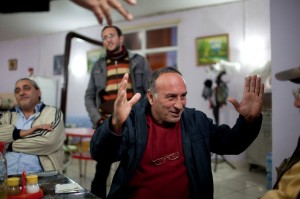 |
Kemal Tatar: “They tell me I’m an Armenian put through the Muslim grinder. I tell them, I’m not a Muslim but an atheist. They reply that I am different.” |
“Religion was never a factor,” says Hamshen communist Kemal Tatar, a friend of Oğuz. “You’ll never hear anyone tell a Hamshen and a Laz who are arguing to reconcile because they’re co-religionists. A Laz would gladly give a girl to a German as a bride than to a Hamshen. Sure, you might note similarities in both peoples, both those similarities and religion don’t lead to a friendly coexistence.”
Even Oğuz’s family didn’t accept Necla with ease. His father is also a socialist, his mother a Turk, and both had no objections to the union. But the father’s mother was dead-set against it. “So now you want to stick an Armenian into this household?” The woman finally came to terms with the match and a joyous wedding took place.
“So you regard the Hamshen as Armenians?” I ask, referring back to what Oğuz’s grandma said. “But many Hamshens don’t even consider themselves Armenians.”
“True, many Hamshens don’t like it when others call them Armenian. Around here, it’s like cursing someone. It’s taken as an insult. Turkish nationalism has created such an atmosphere,” Kemal answers. He continues in Hamshesnak, they call me a converted Armenian. I respond that I’m not a Muslim but an atheist. Their retort is that I’m something different.”
Necla’s father had already passed away prior to the wedding so it was her brother who opposed it.
“His concern was that we’d divorce and that my husband would leave me and I’d end up on the street. My brother said he’d kill him if he did something similar,” Necla tells me. “We Hamshens are more open and would give a girl to a foreigner more easily. It’s those Laz who don’t accept others.”
“So Oğuz, what are differences between the Laz and Hamshens?” I ask.
“I’d prefer not to say since my wife is Hamshen. The Hamshen are more combative, but not in a negative sense. The longer someone stays up in the mountains, the cruder and ruder one gets. Civility increases the further one descends to the sea.”
“And how do the children identify themselves?”
“Sometimes my girl says she’s a mixture, melez,” says Necla. “Then again, my mother always speaks Hamshen in the house and my daughter has learnt the language well. My husband’s side of the family doesn’t speak Lazuri.”
Oğuz is one of the few Laz who actually knows the language. But he rarely uses it.
“It was forbidden to speak Lazuri in the schools. Even though my father was a socialist, he never let us speak it.”
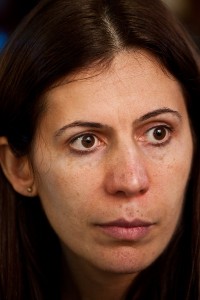 |
Meryem Özçep: “Twenty years from now, no one will regard themselves as Laz. They’ll say that their grandparents were Laz. Once the language disappears, so does ones identity.” |
Meryem Özçep, a former political prisoner and a Laz activist in Hopa, says that she and a few others like her are the last of the Lazuri speakers. The Laz language has been pushed aside in daily life. Today, younger Laz people call themselves Turks. “If they don’t know the language then what makes them Laz?” she asks. “In about twenty years from now no one will identify themselves as Laz. They’ll say my father was a Laz. If the language fades so does ones identity.” Meryem became fluent in Lazuri at a younger age and it saddens her to realize that the language is disappearing.
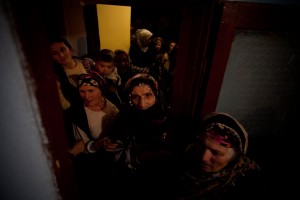 |
| Çamurlu wedding |
“Now, the Laz language is an object of ridicule. It’s only spoken by a few. It will be the first language to die out,” laments Oğuz and mentions his brother, Kâzım Koyuncu, with great pride. Kâzım was a folk-rock singer and song writer, as well as an environmental and cultural activist. Before dying in 2005, he popularized a number of Laz songs and his albums also contain several cuts in Hamshesnak.
Necla says that Hamshesnak is their native language and, unlike Lazuri, it has never been an object of ridicule.
“If I am speaking to someone in Turkish and a Hamshen person shows up, I’ll immediately start talking Hamshesnak to him or her, regardless if the other person understands,” Necla says.
Oğuz gets to hear Hamshesnak spoken more than Lazuri and he’s starting to understand it.
“Does it bother you when they speak Hamshesnak and you might not understand?” I ask.
“On the contrary, I’m amazed that they can keep the language alive.”
Engagement in Hamshen. Mukerem and Sevim.

Marriage in Hamshen. Aydemir and Zulya.

(to be continued)
Khachatur Terteryan assisted in the research work.
Photos by Anahit Hayrapetyan
Translated by Hrant Gadarigian
 Videos
Videos Photos
Photos




Comments (11)
Write a comment